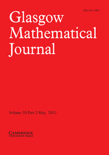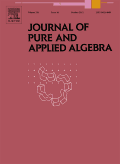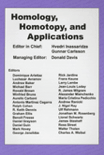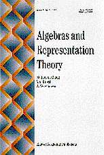
JOURNAL OF ALGEBRA AND ITS APPLICATIONS
Scope & Guideline
Fostering Intellectual Growth in Algebra and Beyond
Introduction
Aims and Scopes
- Algebraic Structures and Their Properties:
The journal covers a wide range of algebraic structures such as groups, rings, algebras, and modules, exploring their properties, representations, and interrelations. - Homological Algebra and Cohomology:
Research involving homological dimensions, cohomological properties, and derived categories is a significant focus, emphasizing the relationships between algebraic structures. - Applications of Algebra in Other Disciplines:
The journal encourages submissions that apply algebraic concepts to areas such as coding theory, cryptography, and combinatorial designs, demonstrating the utility of algebra in solving real-world problems. - Non-commutative Algebra:
A substantial portion of the journal's content is dedicated to non-commutative algebra, including studies of Lie algebras, Hopf algebras, and related structures. - Computational Algebra:
The journal also highlights computational methods in algebra, including algorithms for algebraic structures, applications of computer algebra systems, and combinatorial techniques.
Trending and Emerging
- Algebraic Geometry and Commutative Algebra:
Recent publications indicate a growing interest in the interplay between algebraic geometry and commutative algebra, with a focus on ideals, varieties, and their properties. - Homotopy Theory and Higher Algebra:
There is an increasing trend towards the exploration of higher algebra concepts, including homotopy theory and derived categories, reflecting a broader mathematical interest in categorical and topological methods. - Quantum Groups and Noncommutative Geometry:
Research in quantum groups and noncommutative geometric structures is on the rise, showcasing a shift towards modern algebraic theories that integrate physics and advanced algebra. - Computational Techniques in Algebra:
The application of computational methods and algorithms in algebra is increasingly highlighted, driven by the need for practical approaches to complex algebraic problems. - Lie Theory and Related Algebras:
There has been a notable increase in studies related to Lie algebras, superalgebras, and their applications, indicating a resurgence of interest in these areas.
Declining or Waning
- Classical Group Theory:
While still relevant, classical group theory has seen a decline in focus, with fewer papers dedicated to traditional topics such as finite groups and their properties, as newer algebraic structures gain prominence. - Basic Ring Theory:
Research centered on basic ring theory, including studies of commutative and integral domains, appears to be less frequent, possibly due to the rise of more complex algebraic structures and their applications. - Elementary Algebraic Structures:
Topics covering elementary aspects of algebraic structures, such as basic properties of modules or simple algebraic operations, are becoming less common as researchers delve into more advanced and abstract concepts.
Similar Journals

Documenta Mathematica
Fostering Innovation in the World of MathematicsDocumenta Mathematica is a premier academic journal published by the European Mathematical Society (EMS), making significant contributions to the field of mathematics since its inception. With an Open Access model established in 1996, the journal ensures that scholarly works are freely available to a global audience, promoting widespread dissemination of mathematical research. Based in Germany, it serves as a vital platform for mathematicians, covering a wide array of topics within the discipline, evidenced by its impressive Q1 ranking in the miscellaneous category of mathematics as of 2023. Featuring rigorous peer-reviewed articles that span the latest trends and breakthroughs in the discipline, Documenta Mathematica also retains a commendable position among its peers with a Scopus rank of 163 out of 399, placing it in the 59th percentile for general mathematics. Researchers, professionals, and students alike will benefit from the robust scholarly content and the journal's commitment to advancing mathematical knowledge.

GLASGOW MATHEMATICAL JOURNAL
Unveiling the complexities of mathematics for a global audience.GLASGOW MATHEMATICAL JOURNAL is a prestigious academic publication in the field of mathematics, published by Cambridge University Press since its inception in 1967. This journal, with an ISSN of 0017-0895 and an E-ISSN of 1469-509X, provides a platform for innovative and high-quality research articles, fostering the advancement of mathematical sciences globally. Covering a broad scope, including various subfields, the journal has been recognized in the top quartile (Q2) of the Mathematics (miscellaneous) category according to 2023 rankings, solidifying its importance and credibility within the academic community. The journal is committed to disseminating rigorous research, making it an invaluable resource for researchers, professionals, and students alike, who are keen to stay abreast of the latest developments in the mathematical landscape. By choosing the GLASGOW MATHEMATICAL JOURNAL, authors ensure their work reaches a discerning audience, while readers gain access to cutting-edge theoretical and applied mathematical insights.

JOURNAL OF PURE AND APPLIED ALGEBRA
Advancing the Frontiers of Algebraic KnowledgeJOURNAL OF PURE AND APPLIED ALGEBRA, published by Elsevier, stands as a premier academic platform in the fields of algebra and number theory, boasting a distinguished impact factor that reflects its rigorous peer-review process and influential research contributions. Established in 1971 and continuing its impressive trajectory until 2025, this journal has carved a niche for itself by providing a forum for innovative studies, theoretical advancements, and practical applications within pure and applied algebra. With its prestigious Q1 ranking in Algebra and Number Theory, the journal not only ranks among the top tier in its category but also offers an extensive collection of research that caters to mathematicians, academicians, and students alike. Scholars will find it an invaluable resource for disseminating their findings, as well as keeping abreast of significant developments in the field, further solidifying its role as a cornerstone of mathematical research.

New York Journal of Mathematics
Fostering innovation in the world of mathematics.New York Journal of Mathematics is a prominent open-access journal, published by the ELECTRONIC JOURNALS PROJECT, dedicated to advancing the field of mathematics through the dissemination of groundbreaking research. Since its inception in 1996, the journal has evolved into a valuable resource for researchers, educators, and students, particularly in the realm of general mathematics. As of 2023, it proudly holds a Q2 classification in the Mathematics (miscellaneous) category, reflecting its growing impact and reach within the academic community, despite being ranked at the 31st percentile overall. With its commitment to open access since 2022, the journal ensures that high-quality mathematical research is readily available to a global audience, fostering collaboration and innovation. Researchers interested in contributing to this dynamic field will find the journal a vital platform for sharing their findings and engaging with fellow mathematicians around the world.

Theory and Applications of Categories
Fostering Collaborative Research in Category TheoryTheory and Applications of Categories is a distinguished academic journal published by Mount Allison University in Canada, focusing on the intricate and evolving field of category theory and its diverse applications within mathematics. Since its inception in 1996, the journal has aimed to foster a comprehensive understanding of category theory through the dissemination of high-quality research and innovative findings, maintaining a strong position within the field as evidenced by its Q2 ranking in the 2023 Mathematics (miscellaneous) category. With an impact factor reflective of its relevance, this journal serves as a vital platform for researchers, professionals, and students alike, providing open access for those interested in the latest theoretical advancements and practical applications in this fascinating domain. The journal is committed to promoting collaborative research and stimulating intellectual discourse, ensuring its continued contribution to the mathematical community until at least 2024. For those seeking to expand their knowledge and engage with cutting-edge research, Theory and Applications of Categories represents an essential resource in the realm of mathematics.

Forum of Mathematics Sigma
Fostering collaboration in the world of mathematics.Forum of Mathematics Sigma is a premier open access journal published by Cambridge University Press that has been at the forefront of mathematical research since its inception in 2013. With a strong emphasis on advancing the fields of mathematics, the journal consistently achieves Q1 rankings across multiple categories, including Algebra and Number Theory, Analysis, and Computational Mathematics. This distinction highlights its impact and relevance within the scholarly community. The journal prides itself on providing a platform for innovative research, fostering collaboration among researchers and practitioners across various mathematical disciplines. Open access publication ensures that cutting-edge findings are widely available to readers globally, enhancing the dissemination of knowledge. With an address in the heart of Cambridge, England, Forum of Mathematics Sigma is dedicated to promoting high-quality research and making significant contributions to the development of mathematics.

Homology Homotopy and Applications
Innovating the Future of Topological StudiesHomology Homotopy and Applications is a prestigious peer-reviewed journal published by INT PRESS BOSTON, INC, dedicated to advancing the field of mathematics, particularly within the realms of algebraic topology, homological algebra, and their applications. With an impressive Q1 classification in the mathematics category for the year 2023, this journal serves as a crucial platform for researchers, professionals, and students aiming to disseminate their findings in a rapidly evolving discipline. Although open access options are not currently available, the journal retains significant value with its rigorous selection process and high-impact studies. The journal invites submissions that explore theoretical developments as well as practical applications that bridge homology and homotopy theories, thus contributing to the broader scientific community from its base in the United States. With convergence covering years from 2001 to 2024, Homology Homotopy and Applications continues to be a vital resource for fresh insights and groundbreaking research in mathematical sciences.

ALGEBRAS AND REPRESENTATION THEORY
Elevating Scholarship in Algebra and Representation TheoryALGEBRAS AND REPRESENTATION THEORY, published by SPRINGER, is a premier journal that focuses on the cutting-edge developments in the field of algebra and representation theory. With an ISSN of 1386-923X and an E-ISSN of 1572-9079, this journal has fostered a robust platform for both established and emerging researchers since its inception in 1998. As a Q1 journal in the Mathematics miscellaneous category for 2023, it stands out for its rigorous peer-review process and commitment to academic excellence. Although it is not an open-access journal, its broad scope includes significant theoretical advancements and applications that resonate across various mathematical disciplines. Located at VAN GODEWIJCKSTRAAT 30, 3311 GZ DORDRECHT, NETHERLANDS, ALGEBRAS AND REPRESENTATION THEORY continues to contribute meaningfully to the scientific community by providing researchers with essential insights and fostering collaboration in the increasingly complex landscape of mathematics. Researchers, professionals, and students are encouraged to engage with the latest publications, as the journal plays a critical role in shaping contemporary discussions and innovations in the study of algebraic structures.

CZECHOSLOVAK MATHEMATICAL JOURNAL
Unveiling Innovations in Mathematical ScienceCzechoslovak Mathematical Journal is a distinguished academic journal published by Springer Heidelberg, dedicated to advancing the field of mathematics through the dissemination of high-quality research. With an ISSN of 0011-4642 and E-ISSN 1572-9141, this journal has been a pivotal platform for mathematicians and researchers from around the globe since its inception. The journal holds a Q3 ranking in the field of Mathematics (miscellaneous), demonstrating its commitment to providing a forum for the latest mathematical theories and applications, particularly in general mathematics, as indicated by its Scopus rank of #285/399 and 28th percentile in the field. While currently not offering open access options, the journal continues to attract a wide readership by making its valuable content available through traditional subscription models. The Czechoslovak Mathematical Journal serves as an essential resource for researchers, professionals, and students aiming to stay informed about recent developments and breakthroughs in mathematics, with focus years converging from 1995 to 2024.

International Electronic Journal of Algebra
Empowering Research: A Premier Platform for Algebraic ExplorationThe International Electronic Journal of Algebra (IEJA) is a premier open-access platform dedicated to advancing research in the field of algebra and number theory. Established in Turkey and published by IEJA-INT ELECTRONIC JOURNAL ALGEBRA, this journal has been providing unrestricted access to high-quality scholarly articles since 2007, facilitating the dissemination of valuable findings and innovative methodologies to a global audience. With an ISSN of 1306-6048 and a notable Scopus rank of 85 out of 119 in its category, IEJA contributes significantly to the mathematical community, evidenced by its Q3 quartile ranking in Algebra and Number Theory as of 2023. Researchers, professionals, and students can engage with a diverse range of topics in algebra, enhancing both theoretical understanding and practical applications in this vital area of mathematics. As a journal committed to fostering collaboration and progress, IEJA stands out as an essential resource for anyone seeking to contribute to and learn from the evolving discourse in algebra.